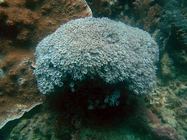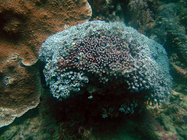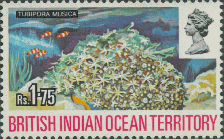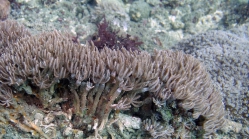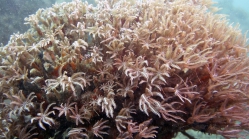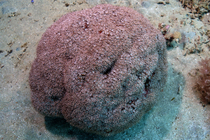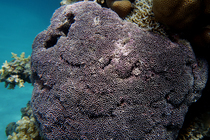Deep-Sea taxon details
Tubipora musica Linnaeus, 1758
207409 (urn:lsid:marinespecies.org:taxname:207409)
accepted
Species
marine, fresh, terrestrial
Linnaeus, C. (1758). Systema Naturae per regna tria naturae, secundum classes, ordines, genera, species, cum characteribus, differentiis, synonymis, locis. <em>Editio decima, reformata [10th revised edition], vol. 1: 824 pp. Laurentius Salvius: Holmiae.</em> , available online at https://biodiversitylibrary.org/page/726886 [details] Available for editors 
Description Red Organ pipe coral. This is not a true coral, but has a limestone skeleton. It is made up of numerous vertical "pipes"...
Description Red Organ pipe coral. This is not a true coral, but has a limestone skeleton. It is made up of numerous vertical "pipes" connected with lateral plates, all of which remain bright red when cleaned. The living coral is usually inconspicuous, because the skeleton is covered by the extended polyps, which are a dull grey. Polyps have eight feathery tentacles. Fragments are conspicuous on beaches due to their red colouration against the while coral sand. It is used medicinally in some Arabian countries as a cure against dysentery. (Sheppard, 1998 <308>) [details]
McFadden, C.S.; Cordeiro, R.; Williams, G.; van Ofwegen, L. (2024). World List of Octocorallia. Tubipora musica Linnaeus, 1758. Accessed through: Glover, A.G.; Higgs, N.; Horton, T. (2024) World Register of Deep-Sea species (WoRDSS) at: https://marinespecies.org/deepsea/aphia.php?p=taxdetails&id=207409 on 2024-04-19
Glover, A.G.; Higgs, N.; Horton, T. (2024). World Register of Deep-Sea species (WoRDSS). Tubipora musica Linnaeus, 1758. Accessed at: https://www.marinespecies.org/deepsea/aphia.php?p=taxdetails&id=207409 on 2024-04-19
Date
action
by
original description
Linnaeus, C. (1758). Systema Naturae per regna tria naturae, secundum classes, ordines, genera, species, cum characteribus, differentiis, synonymis, locis. <em>Editio decima, reformata [10th revised edition], vol. 1: 824 pp. Laurentius Salvius: Holmiae.</em> , available online at https://biodiversitylibrary.org/page/726886 [details] Available for editors 
context source (Deepsea) Intergovernmental Oceanographic Commission (IOC) of UNESCO. The Ocean Biogeographic Information System (OBIS), available online at http://www.iobis.org/ [details]
context source (Hexacorallia) Fautin, Daphne G. (2013). Hexacorallians of the World. (look up in IMIS) [details]
basis of record Veron JEN. (1986). Corals of Australia and the Indo-Pacific. <em>Angus & Robertson Publishers.</em> [details]
additional source Williams, G.C. (1992). Biogeography of the octocorallian coelenterate fauna of southern Africa. <em>Biol. J. Linn. Soc.</em> 46: 351-401.
page(s): 395, 398 [details] Available for editors
additional source Vaughan TW. (1918). Some shallow-water corals from Murray Island (Australia), Cocos-Keeling Island, and Fanning Island. <em>Papers from the Department of Marine Biology of the Carnegie Institution of Washington.</em> 9 (213): 49-234, pls. 20-93. [details]
additional source van Ofwegen, L.P., S.D. Cairns & J. van der Land (eds). (2000-2007). as a contribution to UNESCO-IOC Register of Marine Organisms. (look up in IMIS) [details]
additional source Liu, J.Y. [Ruiyu] (ed.). (2008). Checklist of marine biota of China seas. <em>China Science Press.</em> 1267 pp. (look up in IMIS) [details] Available for editors
additional source Yabe H, Sugiyama T. (1935). Revised list of the reef-corals from the Japanese seas and of the fossil reef corals of the raised reefs and the Ryukyu limestone of Japan. <em>Journal of the Geological Society of Japan.</em> 42: 379-403.
page(s): 390, 401 [details]
additional source Crossland C (1952) Madreporaria, Hydrocorallinae, Heliopora and Tubipora. Scientific Report Great Barrier Reef Expedition 1928-29 VI(3): 85-257.
page(s): 95, 251 [details]
additional source Bayer, F.M., Muzik, K.M. (1977). An Atlantic helioporan coral (Coelenterata: Octocorallia). <em>Proceedings of the Biological Society of Washington.</em> 90: 975–984., available online at https://repository.si.edu/bitstream/handle/10088/975/Bayer-072-1977-pg-975-984.pdf?sequence=1&isAllowed=y
page(s): 976 [details] Available for editors
additional source Wright, E.P.; Studer, T. (1889). Report on the Alcyonaria collected by H.M.S. Challenger during the years 1873-76. <em>Report on the Scientific Results of the Voyage of H.M.S. Challenger during the years 1873–76. Zoology.</em> 31 (part 64), lxxii+ 314 pp., 43 pls. London., available online at https://www.biodiversitylibrary.org/page/2081946
page(s): 252 [details]
additional source Bayer, F. M. (1949). The Alcyonaria of Bikini and other atolls in the Marshall Group. Part I: The Gorgonacea. <em>Pacific Science.</em> 3(3): 195-210., available online at https://www.biodiversitylibrary.org/page/54294584
page(s): 195 [details] Available for editors
additional source Benayahu, Y. (1995). Species composition of soft corals (Octocorallia, Alcyonacea) on the coral reefs of Sesoko Island, Ryukyu Archipelago, Japan. <em>Galaxea.</em> 12: 103–124.
page(s): 119 [details]
additional source Benayahu, Y. (2002). Soft corals (Octocorallia: Alcyonacea) of the southern Ryukyu Archipelago: The families Tubiporidae, Clavulariidae, Alcyoniidae and Briareidae. <em>Journal of the Japanese Coral Reef Society.</em> 2002(4): 11-32., available online at https://www.jstage.jst.go.jp/article/jcrs1999/2002/4/2002_4_11/_article/-char/en
page(s): 13, 14, 25 [details]
additional source Verseveldt, J. (1977). Australian Octocorallia (Coelenterata). <em>Australian Journal of Marine and Freshwater Research.</em> 28: 171-240.
page(s): 172 [details]
additional source Williams, G.C. (1992). The Alcyonacea of southern Africa. Stoloniferous octocorals and soft corals (Coelenterata, Anthozoa). <em>Annals of the South African Museum.</em> 100: 249-358., available online at https://www.biodiversitylibrary.org/page/41110040
page(s): 265, 267, 345, 350 [details]
additional source Utinomi, H. (1971). Intertidal alcyonarians in the vicinity of Darwin, Northern Territory, Australia. <em>Records of the Australian Museum.</em> 28(5): 87-110, plates 15-16.
page(s): 88 [details]
additional source Verseveldt, J. (1960). Biological results of the Snellius expedition. XX. Octocorallia from the Malay Archipelago (Part I). <em>Temminckia.</em> 10: 209-251, plate 7.
page(s): 215 [details]
additional source Utinomi, H. (1956). On some alcyonarians from the West-Pacific islands (Palau, Ponape and Bonins). <em>Publications of the Seto Marine Biological Laboratory.</em> 5(2): 221-242.
page(s): 224 [details]
additional source Utinomi, H. (1959). Fleshy alcyonarians from southern Formosa. <em>Publications of the Seto Marine Biological Laboratory.</em> 7(3): 303-312.
page(s): 304 [details]
additional source Verseveldt, J. (1965). Report on the Octocorallia (Stolonifera and Alcyonacea) of the Israel south Red Sea expedition 1962, with notes on other collections from the Red Sea. <em>Sea Fish Research Station Haifa, Bulletin.</em> 40: 28-48, plate 1.
page(s): 29 [details]
additional source Tixier-Durivault, A. (1970). Les Octocoralliaires de Nouvelle-Calédonie. <em>L'Expédition française sur les récifs coralliens de la Nouvelle-Calédonie organisée sous l'égide de la fondation Singer-Polignac 1960-1963.</em> 4: 171-350.
page(s): 179 [details] Available for editors
additional source Macfadyen, L.M.I. (1936). Alcyonaria (Stolonifera, Alcyonacea, Telestacea and Gorgonacea). <em>Great Barrier Reef Expedition 1928-1929, Scientific Reports.</em> 5(2): 19-71, plates 1-5.
page(s): 26 [details]
additional source Imahara, Y. (1991). Report on the Octocorallia from the Ryukyu Islands of Japan. <em>Bull. Inst. Oceanic Res. & Develop., Tokai Univ.</em> 11/12: 59-94.
page(s): 60 [details]
additional source Hickson, S.J.; Hiles, I.L. (1900). The Stolonifera and Alcyonacea collected by Dr. Willey in New Britain, etc. <em>Zoological results based on material from New Britain, New Guinea, Loyalty Islands and elsewhere, collected during the years 1895, 1896, and 1897.</em> 4: 493-508, plates 50-51., available online at https://biodiversitylibrary.org/page/21340323
page(s): 493-494 [details]
additional source Thomson, J.A.; Dean, L.M.I. (1931). The Alcyonacea of the Siboga expedition with an addendum to the Gorgonacea. <em>Siboga Expeditie.</em> XIIId: 1-227, plates 1-28.
page(s): 22 [details]
additional source Randall RH, Myers RF. (1983). The corals. Guide to the Coastal Resources of Guam: Vol. 2. <em>University of Guam Press, Guam, pp. 128.</em> [details]
additional source Deichmann, E. (1936). The Alcyonaria of the western part of the Atlantic Ocean. <em>Memoirs of the Museum of Comparative Zoology, Harvard College.</em> 53: 1-317, plates 1-37., available online at https://www.biodiversitylibrary.org/page/4363633
page(s): 37, 39 [details]
additional source Bayer, F. M. (1959). The alcyonarian and black corals (Anthozoa, Octocorallia and Antipatharia) described and figured by G.E. Rumphius. H. C. D. de Wit (eds.). Uitgeverij en Drukkerij Hollandia N.V. Baarn, pp. 225-247
page(s): 241 [details] Available for editors
additional source Wells JW. (1954). Recent corals of the Marshall Islands: Bikini and nearby atolls, part 2, oceanography (biologic). <em>U.S. Geological Survey Professional Paper.</em> 260(I): 385-486.
page(s): 385, 395, 397, 474 [details]
additional source Grasshoff, M.; Bargibant, G. (2001). Coral Reef Gorgonians of New Caledonia. IRD Èditions. Paris., pp. 335.
page(s): 34, 36, 37, 208, 209, 314, 315 [details]
additional source Sheppard, C. R. C. (1985). Fringing reefs in the southern region, Jeddah to Jizan. Fauna of Saudi Arabia, 7, 37-58
page(s): 46 [details]
additional source Fabricius, K.; Alderslade, P. (2001). Soft Corals and Sea Fans: A Comprehensive Guide to the Shallow-water Genera of the Central-West Pacific, the Indian Ocean and the Red Sea. <em>Australian Institute of Marine Science. Townsville.</em> pp. 264.
page(s): 14, 76 [details]
additional source Dullo, W.; Gektidis, M.; Golubic, S.; Heiss, G. A.; Kampmann, H.; Kiene, W.; Kroll, D. K.; Kuhrau, M. L.; Radtke, G.; Reijmer, J. G.; Reinicke, G. B.; Schlichter, D.; Schuhmacher, H.; Vogel, K. (1995). Factors controlling Holocene reef growth: an interdisciplinary approach. Facies, 32, 145-188
page(s): 167 [details]
additional source Tixier-Durivault, A. (1940). Contribution a l'étude du métabolisme du calcium et du fer chez l'Alcyonium palmatum Pallas. Annales de l'Institute Oceanographique, 20(1): 311-379, plate 1
page(s): 370, 373 [details]
additional source Benayahu, Y.; Jeng, M. S.; Perkol-Finkel, S.; Dai, C. F. (2004). Soft corals (Octocorallia: Alcyonacea) from southern Taiwan. II. Species diversity and distributional patterns. Zoological Studies, 43(3): 548-560
page(s): 550 [details]
additional source Reinicke, G. B.; van Ofwegen, L. P. (1999). Soft corals (Alcyonacea: Octocorallia) from shallow water in the Chagos Archipelago: species assemblages and their distribution. Linnean Society Occasional Publications, 2, 67-85, plates 1-10
page(s): 68, 69, 71, 84 [details]
additional source Benayahu, Y.; Yosief, T.; Schleyer, M. H. (2002). Soft corals (Octocorallia, Alcyonacea) of the southern Red Sea. Israel Journal of Zoology, 48, 273-283
page(s): 278 [details]
additional source Benayahu, Y.; Shlagman, A.; Schleyer, M. H. (2003). Corals of the south-west Indian Ocean: VI. The Alcyonacea (Octocorallia) of Mozambique, with a discussion on soft coral distribution on south equatorial East African reefs. Zoologische Verhandelingen, 345, 49-57
page(s): 55 [details]
additional source Kühlmann, D. H. H. (2006). Die Steinkorallensammlung im Naturhistorischen Museum in Rudolstadt (Thüringen) nebst ökologischen Bemerkungen. Rudolstädter Naturhistorische Schriften, 13, 37-113
page(s): 64, 106-107, 112 [details]
additional source Imahara, Y. (1996). Previously recorded octocorals from Japan and adjacent seas. Precious Corals and Octocoral Research, 4-mei, 17-44
page(s): 19 [details]
context source (Deepsea) Intergovernmental Oceanographic Commission (IOC) of UNESCO. The Ocean Biogeographic Information System (OBIS), available online at http://www.iobis.org/ [details]
context source (Hexacorallia) Fautin, Daphne G. (2013). Hexacorallians of the World. (look up in IMIS) [details]
basis of record Veron JEN. (1986). Corals of Australia and the Indo-Pacific. <em>Angus & Robertson Publishers.</em> [details]
additional source Williams, G.C. (1992). Biogeography of the octocorallian coelenterate fauna of southern Africa. <em>Biol. J. Linn. Soc.</em> 46: 351-401.
page(s): 395, 398 [details] Available for editors
additional source Vaughan TW. (1918). Some shallow-water corals from Murray Island (Australia), Cocos-Keeling Island, and Fanning Island. <em>Papers from the Department of Marine Biology of the Carnegie Institution of Washington.</em> 9 (213): 49-234, pls. 20-93. [details]
additional source van Ofwegen, L.P., S.D. Cairns & J. van der Land (eds). (2000-2007). as a contribution to UNESCO-IOC Register of Marine Organisms. (look up in IMIS) [details]
additional source Liu, J.Y. [Ruiyu] (ed.). (2008). Checklist of marine biota of China seas. <em>China Science Press.</em> 1267 pp. (look up in IMIS) [details] Available for editors
additional source Yabe H, Sugiyama T. (1935). Revised list of the reef-corals from the Japanese seas and of the fossil reef corals of the raised reefs and the Ryukyu limestone of Japan. <em>Journal of the Geological Society of Japan.</em> 42: 379-403.
page(s): 390, 401 [details]
additional source Crossland C (1952) Madreporaria, Hydrocorallinae, Heliopora and Tubipora. Scientific Report Great Barrier Reef Expedition 1928-29 VI(3): 85-257.
page(s): 95, 251 [details]
additional source Bayer, F.M., Muzik, K.M. (1977). An Atlantic helioporan coral (Coelenterata: Octocorallia). <em>Proceedings of the Biological Society of Washington.</em> 90: 975–984., available online at https://repository.si.edu/bitstream/handle/10088/975/Bayer-072-1977-pg-975-984.pdf?sequence=1&isAllowed=y
page(s): 976 [details] Available for editors
additional source Wright, E.P.; Studer, T. (1889). Report on the Alcyonaria collected by H.M.S. Challenger during the years 1873-76. <em>Report on the Scientific Results of the Voyage of H.M.S. Challenger during the years 1873–76. Zoology.</em> 31 (part 64), lxxii+ 314 pp., 43 pls. London., available online at https://www.biodiversitylibrary.org/page/2081946
page(s): 252 [details]
additional source Bayer, F. M. (1949). The Alcyonaria of Bikini and other atolls in the Marshall Group. Part I: The Gorgonacea. <em>Pacific Science.</em> 3(3): 195-210., available online at https://www.biodiversitylibrary.org/page/54294584
page(s): 195 [details] Available for editors
additional source Benayahu, Y. (1995). Species composition of soft corals (Octocorallia, Alcyonacea) on the coral reefs of Sesoko Island, Ryukyu Archipelago, Japan. <em>Galaxea.</em> 12: 103–124.
page(s): 119 [details]
additional source Benayahu, Y. (2002). Soft corals (Octocorallia: Alcyonacea) of the southern Ryukyu Archipelago: The families Tubiporidae, Clavulariidae, Alcyoniidae and Briareidae. <em>Journal of the Japanese Coral Reef Society.</em> 2002(4): 11-32., available online at https://www.jstage.jst.go.jp/article/jcrs1999/2002/4/2002_4_11/_article/-char/en
page(s): 13, 14, 25 [details]
additional source Verseveldt, J. (1977). Australian Octocorallia (Coelenterata). <em>Australian Journal of Marine and Freshwater Research.</em> 28: 171-240.
page(s): 172 [details]
additional source Williams, G.C. (1992). The Alcyonacea of southern Africa. Stoloniferous octocorals and soft corals (Coelenterata, Anthozoa). <em>Annals of the South African Museum.</em> 100: 249-358., available online at https://www.biodiversitylibrary.org/page/41110040
page(s): 265, 267, 345, 350 [details]
additional source Utinomi, H. (1971). Intertidal alcyonarians in the vicinity of Darwin, Northern Territory, Australia. <em>Records of the Australian Museum.</em> 28(5): 87-110, plates 15-16.
page(s): 88 [details]
additional source Verseveldt, J. (1960). Biological results of the Snellius expedition. XX. Octocorallia from the Malay Archipelago (Part I). <em>Temminckia.</em> 10: 209-251, plate 7.
page(s): 215 [details]
additional source Utinomi, H. (1956). On some alcyonarians from the West-Pacific islands (Palau, Ponape and Bonins). <em>Publications of the Seto Marine Biological Laboratory.</em> 5(2): 221-242.
page(s): 224 [details]
additional source Utinomi, H. (1959). Fleshy alcyonarians from southern Formosa. <em>Publications of the Seto Marine Biological Laboratory.</em> 7(3): 303-312.
page(s): 304 [details]
additional source Verseveldt, J. (1965). Report on the Octocorallia (Stolonifera and Alcyonacea) of the Israel south Red Sea expedition 1962, with notes on other collections from the Red Sea. <em>Sea Fish Research Station Haifa, Bulletin.</em> 40: 28-48, plate 1.
page(s): 29 [details]
additional source Tixier-Durivault, A. (1970). Les Octocoralliaires de Nouvelle-Calédonie. <em>L'Expédition française sur les récifs coralliens de la Nouvelle-Calédonie organisée sous l'égide de la fondation Singer-Polignac 1960-1963.</em> 4: 171-350.
page(s): 179 [details] Available for editors
additional source Macfadyen, L.M.I. (1936). Alcyonaria (Stolonifera, Alcyonacea, Telestacea and Gorgonacea). <em>Great Barrier Reef Expedition 1928-1929, Scientific Reports.</em> 5(2): 19-71, plates 1-5.
page(s): 26 [details]
additional source Imahara, Y. (1991). Report on the Octocorallia from the Ryukyu Islands of Japan. <em>Bull. Inst. Oceanic Res. & Develop., Tokai Univ.</em> 11/12: 59-94.
page(s): 60 [details]
additional source Hickson, S.J.; Hiles, I.L. (1900). The Stolonifera and Alcyonacea collected by Dr. Willey in New Britain, etc. <em>Zoological results based on material from New Britain, New Guinea, Loyalty Islands and elsewhere, collected during the years 1895, 1896, and 1897.</em> 4: 493-508, plates 50-51., available online at https://biodiversitylibrary.org/page/21340323
page(s): 493-494 [details]
additional source Thomson, J.A.; Dean, L.M.I. (1931). The Alcyonacea of the Siboga expedition with an addendum to the Gorgonacea. <em>Siboga Expeditie.</em> XIIId: 1-227, plates 1-28.
page(s): 22 [details]
additional source Randall RH, Myers RF. (1983). The corals. Guide to the Coastal Resources of Guam: Vol. 2. <em>University of Guam Press, Guam, pp. 128.</em> [details]
additional source Deichmann, E. (1936). The Alcyonaria of the western part of the Atlantic Ocean. <em>Memoirs of the Museum of Comparative Zoology, Harvard College.</em> 53: 1-317, plates 1-37., available online at https://www.biodiversitylibrary.org/page/4363633
page(s): 37, 39 [details]
additional source Bayer, F. M. (1959). The alcyonarian and black corals (Anthozoa, Octocorallia and Antipatharia) described and figured by G.E. Rumphius. H. C. D. de Wit (eds.). Uitgeverij en Drukkerij Hollandia N.V. Baarn, pp. 225-247
page(s): 241 [details] Available for editors
additional source Wells JW. (1954). Recent corals of the Marshall Islands: Bikini and nearby atolls, part 2, oceanography (biologic). <em>U.S. Geological Survey Professional Paper.</em> 260(I): 385-486.
page(s): 385, 395, 397, 474 [details]
additional source Grasshoff, M.; Bargibant, G. (2001). Coral Reef Gorgonians of New Caledonia. IRD Èditions. Paris., pp. 335.
page(s): 34, 36, 37, 208, 209, 314, 315 [details]
additional source Sheppard, C. R. C. (1985). Fringing reefs in the southern region, Jeddah to Jizan. Fauna of Saudi Arabia, 7, 37-58
page(s): 46 [details]
additional source Fabricius, K.; Alderslade, P. (2001). Soft Corals and Sea Fans: A Comprehensive Guide to the Shallow-water Genera of the Central-West Pacific, the Indian Ocean and the Red Sea. <em>Australian Institute of Marine Science. Townsville.</em> pp. 264.
page(s): 14, 76 [details]
additional source Dullo, W.; Gektidis, M.; Golubic, S.; Heiss, G. A.; Kampmann, H.; Kiene, W.; Kroll, D. K.; Kuhrau, M. L.; Radtke, G.; Reijmer, J. G.; Reinicke, G. B.; Schlichter, D.; Schuhmacher, H.; Vogel, K. (1995). Factors controlling Holocene reef growth: an interdisciplinary approach. Facies, 32, 145-188
page(s): 167 [details]
additional source Tixier-Durivault, A. (1940). Contribution a l'étude du métabolisme du calcium et du fer chez l'Alcyonium palmatum Pallas. Annales de l'Institute Oceanographique, 20(1): 311-379, plate 1
page(s): 370, 373 [details]
additional source Benayahu, Y.; Jeng, M. S.; Perkol-Finkel, S.; Dai, C. F. (2004). Soft corals (Octocorallia: Alcyonacea) from southern Taiwan. II. Species diversity and distributional patterns. Zoological Studies, 43(3): 548-560
page(s): 550 [details]
additional source Reinicke, G. B.; van Ofwegen, L. P. (1999). Soft corals (Alcyonacea: Octocorallia) from shallow water in the Chagos Archipelago: species assemblages and their distribution. Linnean Society Occasional Publications, 2, 67-85, plates 1-10
page(s): 68, 69, 71, 84 [details]
additional source Benayahu, Y.; Yosief, T.; Schleyer, M. H. (2002). Soft corals (Octocorallia, Alcyonacea) of the southern Red Sea. Israel Journal of Zoology, 48, 273-283
page(s): 278 [details]
additional source Benayahu, Y.; Shlagman, A.; Schleyer, M. H. (2003). Corals of the south-west Indian Ocean: VI. The Alcyonacea (Octocorallia) of Mozambique, with a discussion on soft coral distribution on south equatorial East African reefs. Zoologische Verhandelingen, 345, 49-57
page(s): 55 [details]
additional source Kühlmann, D. H. H. (2006). Die Steinkorallensammlung im Naturhistorischen Museum in Rudolstadt (Thüringen) nebst ökologischen Bemerkungen. Rudolstädter Naturhistorische Schriften, 13, 37-113
page(s): 64, 106-107, 112 [details]
additional source Imahara, Y. (1996). Previously recorded octocorals from Japan and adjacent seas. Precious Corals and Octocoral Research, 4-mei, 17-44
page(s): 19 [details]
 Present
Present  Inaccurate
Inaccurate  Introduced: alien
Introduced: alien  Containing type locality
Containing type locality
Nontype AM G14720, geounit Australian Exclusive Economic Zone [details]
Nontype AM G14721, geounit Australian Exclusive Economic Zone [details]
Nontype ZMTAU 28710, geounit Japanese Exclusive Economic Zone [details]
Nontype ZMTAU Co 28699, geounit Japanese Exclusive Economic Zone [details]
Nontype ZMTAU Co 28709, geounit Japanese Exclusive Economic Zone [details]
Nontype ZMTAU Co 28711, geounit Japanese Exclusive Economic Zone [details]
Nontype ZMTAU Co 28712, geounit Japanese Exclusive Economic Zone [details]
Nontype ZMTAU Co 28713, geounit Japanese Exclusive Economic Zone [details]
Nontype ZMTAU Co 28717, geounit Japanese Exclusive Economic Zone [details]
Nontype ZMTAU Co 29193, geounit Taiwanese Exclusive Economic Zone [details]
Nontype ZMTAU Co 30169, geounit Chinese Exclusive Economic Zone [details]
Nontype ZMTAU Co 30256, geounit Chinese Exclusive Economic Zone [details]
Nontype ZMTAU Co 31260, geounit Mozambican Exclusive Economic Zone [details]
From other sources
Biology zooxanthellate [details]Description Red Organ pipe coral. This is not a true coral, but has a limestone skeleton. It is made up of numerous vertical "pipes" connected with lateral plates, all of which remain bright red when cleaned. The living coral is usually inconspicuous, because the skeleton is covered by the extended polyps, which are a dull grey. Polyps have eight feathery tentacles. Fragments are conspicuous on beaches due to their red colouration against the while coral sand. It is used medicinally in some Arabian countries as a cure against dysentery. (Sheppard, 1998 <308>) [details]
Habitat coastal [details]
| Language | Name | |
|---|---|---|
| English | red organ pipe coralpipe-organ coralorgan-pipe coralorgan pipe coral | [details] |
| German | Orgelkoralle | [details] |
| Japanese | クダサンゴ | [details] |
To Barcode of Life (15 barcodes)
To Biodiversity Heritage Library (304 publications)
To Biological Information System for Marine Life (BISMaL)
To European Nucleotide Archive (ENA)
To GenBank (27 nucleotides; 48 proteins)
To Global Biotic Interactions (GloBI)
To IUCN Red List (Near Threatened)
To USNM Invertebrate Zoology Cnidaria Collection (85 records)
To ITIS
To Biodiversity Heritage Library (304 publications)
To Biological Information System for Marine Life (BISMaL)
To European Nucleotide Archive (ENA)
To GenBank (27 nucleotides; 48 proteins)
To Global Biotic Interactions (GloBI)
To IUCN Red List (Near Threatened)
To USNM Invertebrate Zoology Cnidaria Collection (85 records)
To ITIS

